Galápagos
A unique gem in the Pacific Ocean. Experience what it is like to detach from daily life and truly be at one with nature, not found anywhere else on earth....
Discover Galápagos
Neotropical birds on the flanks of the Andes – this is your introduction to Ecuador’s bird paradise
“The rewards of birding here are unsurpassed; it just does not get better than this!”
The Neotropics are widely regarded as being packed with thousands of confusing birds in difficult birding conditions. This can be true, but the rewards of birding here are unsurpassed. After just a week of seeing numerous new families and having the intricacies of Neotropical birding explained, you will find it is highly addictive. It just does not get better than this. For those of you who would feel empty if you left Ecuador without a condor, we have added a short High Andes extension.
This tour is designed to be an introduction to Neotropical birds. The guide will attempt to show you representatives of all the Neotropical families, even if they are common birds. While finding the regional endemics is a secondary focus of the tour, you will still see quite a lot of them, and you certainly do not have to be a novice to enjoy the trip. Quite often more experienced birders join this tour, since it is a shorter and less expensive tour than most. This is a bird-focused tour, and opportunities to see other wildlife are limited.
(Photos courtesy of Tandayapa Bird Lodge)
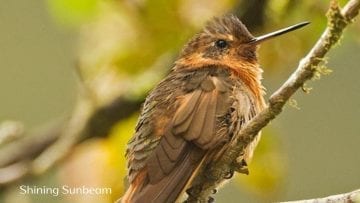
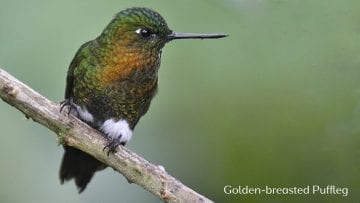
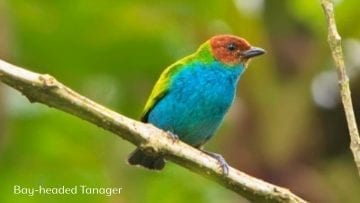
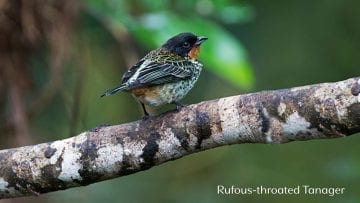
Moderate. Early starts are necessary on most days since birding in the Andes is almost always best early in the morning, and breakfast will typically start between 4:30 and 5:30am. To get to the farther birding sites (Rio Silanche and Mashpi), drives of 1.5-2 hours each way are required, but the drives are much shorter on other days. On a few days there will be some downtime either after lunch, or after arriving back to the lodge after the day’s birding excursion, but on at least one or two days you may arrive back at the lodge after dark. At least four lunches will be packed lunches, and one breakfast will likely be a packed breakfast. Apart from the two nights in Quito, all nights are spent at Tandayapa Bird Lodge, so you don’t have the hassle of packing and unpacking every day.
Moderate. Most of the birding will be on flat or slightly inclined roads or wide tracks. Paz de las Aves, which is visited on one day, has some fairly steep and muddy trails (a walking stick helps a lot), but they are relatively short. You can expect to walk around 3 – 5 km per day on average. All morning of day two of the main tour will be spent at 3500 m. elevation, but most of the walking is on a wide, nearly flat track which will be done at slow pace. Much of the High Andes Extension will be spent at elevations above 3500 m.
The primary purpose of this tour is to have all the clients see as many birds as possible, and seeing the birds will always take priority over getting photos. We do allow photography on our tours, but the tour leader will not allow photographers to move in front of the group for a photo until everyone has had a good look at the bird. All of our guides are also amateur photographers, so they are happy to help you out within the limitations given here. On this tour, the photographic opportunities are quite good at the many feeding stations that we visit for hummingbirds, tanagers, and others. Away from the feeders it is more challenging, and there may be little time to spend photographing if there are other birds around to see.
Aves Travels makes a clear distinction between birding tours and bird photography tours (refer to our blog: Exclusive birding and photography tours). If you are interested in a tour with a stronger focus on photography, please contact us!
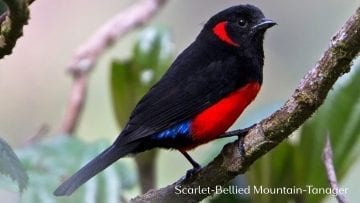
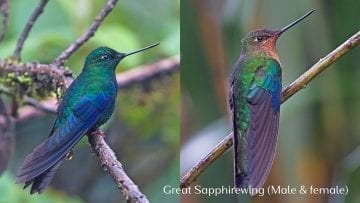
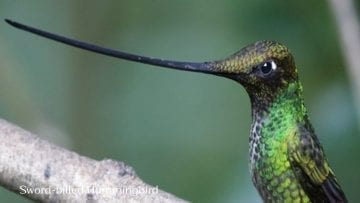
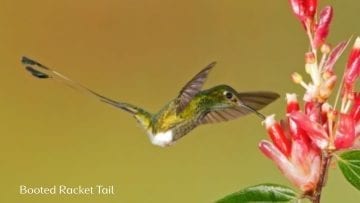
Upon arrival, you will be transferred to a hotel in the Quito tourist district, about 45 minutes away. Note that some people choose to arrive a day early to acclimatize and see some of the sites of the city. Please contact us if you are interested in this, we would be happy to book you an extra night at the hotel, and optionally arrange a city tour. As most flights arrive in the evening, there are no birding activities on this day.
(Night and dinner in an excellent 4* hotel)
Your guide will meet you at breakfast in the Quito hotel, and we’ll drive to the beautiful Yanacocha reserve in the elfin forest cloaking the scenic slopes of Pichincha Volcano, about an hour and a half from our hotel in Quito. Although the surrounding terrain is steep, walking here is easy (as the trail is almost totally flat, about 3,5 kilometres roundtrip) and the birds are amazing. It’s a great place to start since most of the birds are easy to see and the diversity is lower than at the sites visited on the remainder of the main tour. There are mixed species feeding flocks with gorgeous mountain-tanagers like Scarlet-bellied, Hooded, and Black-chested, which mix with other species like Spectacled Redstart and Supercilaried Hemispingus. However, arguably it is the hummingbirds that will be the highlights of the first morning. Some of the hummingbirds at Yanacocha rank as some of the most spectacular in the world, and are easy to see by virtue of a marvelous set of well-placed feeders, which regularly attract Great Sapphirewing, Tyrian Metaltail, Sapphire-vented and Golden-breasted Pufflegs, and Sword-billed Hummingbird. The reserve is run by an Ecuadorian NGO, the Jocotoco Foundation, and was bought in order to preserve vital habitat for another hummingbird, the critically endangered Black-breasted Puffleg. Although it occurs in the reserve, it remains rare and poorly known, and we would need a lot of luck to see it!
After a full morning in the reserve, and taking lunch in the field on site, we will continue our journey towards Tandayapa, driving down the Old Nono-Mindo Road in the afternoon. This road is an established birding “ecoroute”, and we will make selected stops to look for a few other birds such as Andean Lapwing, Slaty-backed Chat-Tyrant, White-capped Dipper, and, with luck, maybe even Torrent Duck. There is always the chance too of bumping into another mixed flock, which as we are driving down in altitude, into the subtropical zone, could comprise many new species like Blue-winged Mountain-Tanager, White-tailed Tyrannulet, Capped Conebill, and Beryl-spangled Tanager. Later in the afternoon, we’ll arrive at Tandayapa Bird Lodge, where we will be based for the next five nights. We’ll try to arrive before dark to get our first view of the incredible hummingbird feeders, which can attract anywhere from 12 to 20 species in an hour, including Booted Racket-tail, Violet-tailed Sylph, Brown Inca, Purple-bibbed White-tip, Western Emerald, and Purple-throated Woodstar.
(5:00am breakfast at the Quito hotel; lunch in a restaurant at Yanacocha OR a packed lunch; dinner and night in Tandayapa Bird Lodge. For more information about the lodge click here)
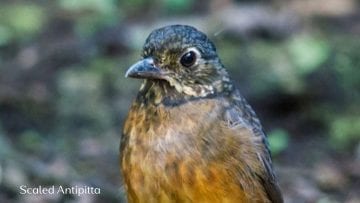
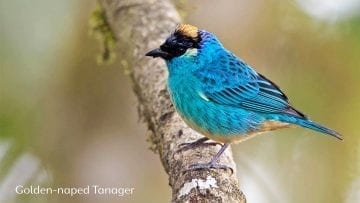
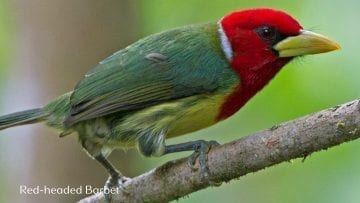
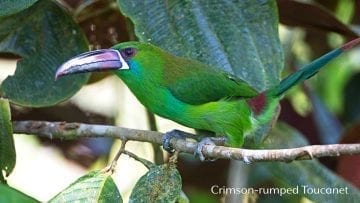
A forest blind, a ten minute walk from the lodge, allows for great opportunities to see some very shy cloudforest species up close, such as White-throated Quail-Dove, Russet-crowned Warbler, Zeledon’s Antbird, Streak-capped Treehunter, Strong-billed Woodcreeper, and sometimes even Scaled Antpitta. The walk will be taken in darkness, pre-dawn, so that we arrive at the blind right around daybreak (around 6.00am), when the most bird activity is to be expected. The birds are attracted there by a large light which attracts a variety of moths during the night, and which are then preyed upon by the attendant birds early in the morning. (For those people still recovering from their flights and a hectic first day’s birding, you are free to skip this activity, remain at the lodge and meet us there for breakfast at 7:00am). After around 30 minutes at the blind, we’ll return to the lodge for breakfast, which can also be a peak of bird activity around the building itself; there are often several brush-finches (White-winged and Tricolored), Masked Trogon, Gray-breasted Wood-Wren, Golden-crowned Flycatcher, Slate-throated Whitestart, Toucan Barbets, and others, close-by and easy-to-see. Activity at the fruit feeders varies seasonally, but when they are busy they can be superb, with the likes of Golden and Golden-naped Tanagers, Blue-winged Mountain-Tanager, Red-headed Barbet, Crimson-rumped Toucanet, and several others coming in very close.
After breakfast, we’ll bird nearby trails and the entrance road of the lodge, looking for mixed feeding flocks that are formed by a variety of colorful tanagers including Metallic-green, Flame-faced, Golden, Silver-throated, White-winged, and Beryl-spangled together with other attractive passerines like Black-winged Saltator and Ornate Flycatcher. This walk can also produce some less common birds like Beautiful Jay, Golden-headed Quetzal, Streak-headed Antbird, and possibly even soaring raptors including the rare Black-and-chestnut Eagle.
The afternoon plan will depend on how we did during the morning; we might bird again the lower portions of the valley, or move up in elevation depending on which birds we decide to target. Weather permitting; we may stay until dusk to try to find some nightbirds, such as Lyre-tailed Nightjar.
(All meals and night in Tandayapa Bird Lodge).
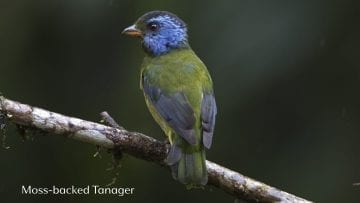
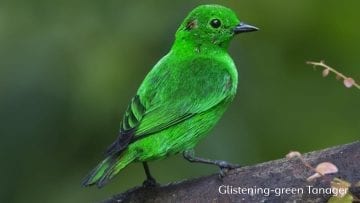
It’s about a 1.5 hour drive to an easy dirt road that passes through verdant cloudforest loaded with some absolutely superb Chocó endemics not easily seen elsewhere, including Orange-breasted Fruiteater, Indigo Flowerpiercer, Moss-backed Tanager, Black-chinned Mountain-Tanager, Glistening-green Tanager, and Buffy (Pacific) Tuftedcheek. With luck, this area could also produce Uniform Treehunter, Black Solitaire, or Esmeraldas Antbird. Other targets in the Mashpi area include Blue-tailed (Chocó) Trogon, Ochre-breasted Tanager, and Rufous-throated Tanager. There are dizzying flocks that roam the humid forests in this area, which hold birds like Red-faced Spinetail, Scaly-throated, Buff-fronted and Lineated Foliage-gleaners, Golden-crowned (Choco) Warbler, Slaty Antwren, Tawny-breasted Flycatcher, and Cinnamon Becard.
We’ll visit a small, local reserve where the owners have set a system of feeders that attract some of these desired birds for us to get splendid views, and with some luck, some great photos. The hummer feeders attract some of the more localized species, and this is our best chance to see the astonishing Velvet-purple Coronet and the elegant Empress Brilliant.
The plan for the afternoon is somewhat flexible depending on the weather, and we might bird some lower elevations nearby, or go to another local site like Milpe for other foothill species. The exact plan for this afternoon will be decided by the guide, based on what is best for the birds at the time of the tour.
(Breakfast around 4:30am, packed lunch in the field, dinner and night in Tandayapa Bird Lodge)
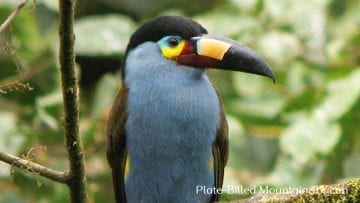
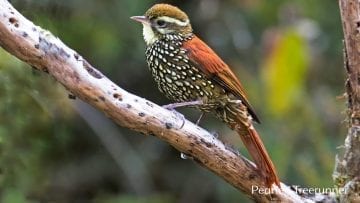
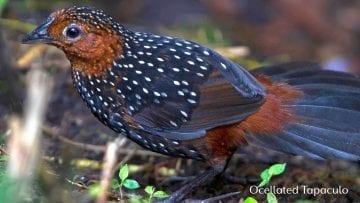
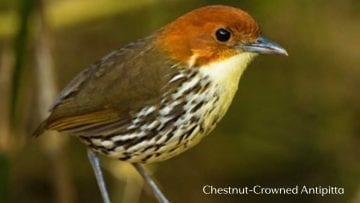
After breakfast, we head up the road to higher elevations of the valley (about a 20 minute drive), looking for the very rare Tanager Finch, the beautiful Toucan Barbet, and the spectacular Plate-billed Mountain-Toucan. A host of other subtropical species also occur such as Gorgeted Sunangel, Collared Inca, Green-and-black Fruiteater, Grass-green Tanager, Dusky Chlorospingus (Bush-Tanager), and Pearled Treerunner. After returning to the lodge for lunch, we might spend some extra time at the hummer feeders before we head out again. Later that afternoon, depending in rain and bird activity around the lodge, there may be another, optional, excursion a short distance upslope from the lodge. Those who wish to soak in the hummingbirds further, or simply spend some further time relaxing around the lodge, are welcome to do to. We typically return to the upper valley to try for more difficult skulkers like Plain-tailed Wren, Striped Treehunter, Rufous-headed Pygmy-Tyrant, Ocellated Tapaculo, or Chestnut-crowned Antpitta.
(Breakfast in the lodge around 5:30am, lunch could be either a packed lunch or taken in the lodge, dinner and night in Tandayapa Bird Lodge)
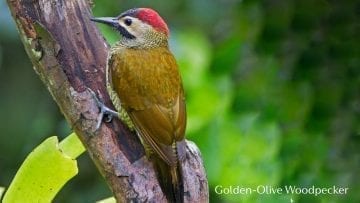
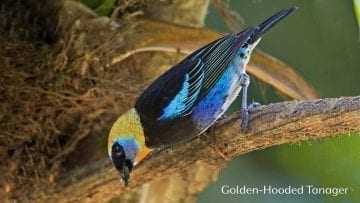
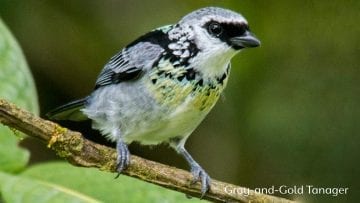
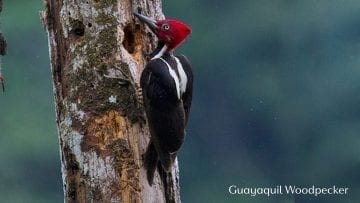
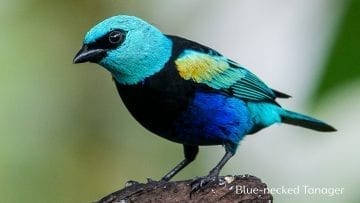
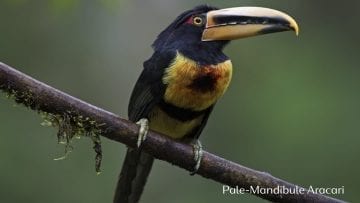
We’ll spend the day in lowland tropical rainforest at the Rio Silanche Bird Sanctuary, and we can expect to see loads of new birds. It’s a 1½-hour drive, but well worth it when the birds start coming in thick and fast. Luckily, after the previous five days, you will be ready for this onslaught. A whole host of new and spectacular tanagers is possible, such as Scarlet-browed, Rufous-winged, Gray-and-gold, Guira, Blue-necked, Bay-headed, and Golden-hooded, and up to four species of dacnises can be seen here on a good day. Understory flocks have a bewildering array of skulkers like antwrens, foliage-gleaners, and flycatchers, while larger birds can include several species of trogon, toucans, trogons, and maybe even some interesting raptors. The area is also rich in woodpeckers, with Guayaquil, Lineated, Cinnamon, Golden-olive, Black-cheeked, and Red-rumped all possible, along with Olivaceous Piculet too. There are also puffbirds in the area with both White-whiskered and Barred Puffbirds regularly seen. While the habitat is very fragmented, the combination of forest edge, cleared areas, pastures, plantations, and remaining forest patches lead to big day lists; it is no uncommon to pick up well over a hundred species in a day here, and therefore it is easy to see why it is often a favorite. The area is also good for toucans and parrots, with afternoon drives along the road near the reserve regularly finding Choco and Black-mandibled (Chestnut-mandibled) Toucans, Collared (Pale-mandibled) Aracari, and Bronze-winged Parrot. The birding is along roads and easy trails, with the toughest aspect of the day being the high humidity of the lowlands.
(Breakfast in the lodge around 4:30am, packed lunch in the field, dinner and night in Tandayapa Bird Lodge)
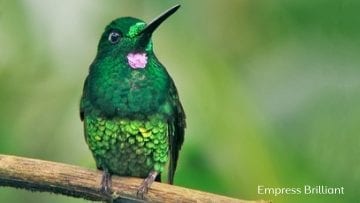
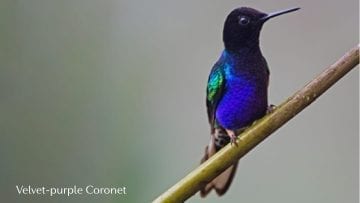
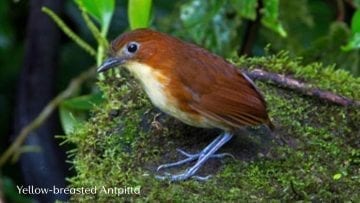
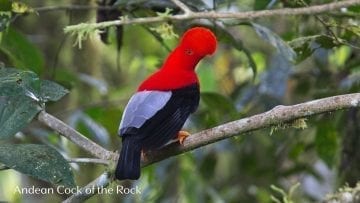
Paz de Aves is a small, private reserve about 40 minutes away near the town of Mindo, and is sure to be a highlight of the tour. Here, a local farmer became an instant birding sensation when he started feeding worms to Giant, Moustached, Yellow-breasted, Ochre-breasted, and Chestnut-crowned Antpittas with amazing success. Every visit is different, but we typically see at least two antpittas, and sometimes more. The appeal of this site is that these normally shy birds of the dark forest floor often come into view and can be seen very well by everyone present. We will need to leave very early in order to get there at dawn, as the antpittas are not the only attraction on site. At dawn (around 06:00am), it is possible to watch the amazing displays of a handful of male Andean Cock-of-the-rock, which gather each day at “leks” in order to compete for the attraction of any passing females. The trail down into the forest is quite steep and sometimes muddy though not very long, and a walking stick is recommended. The reserve also has a small set of hummingbird feeders which regularly bring in the spectacular Velvet-purple Coronet and Empress Brilliant, if we did not see them at Tandayapa or Mashpi. Other possibilities here include Black-chinned Mountain-Tanager, Toucan Barbet, Olivaceous Piha, and Sickle-winged Guan.
We’ll return to Tandayapa for lunch, and, after some final time with the hummingbirds of Tandayapa, we’ll pack up and head back to Quito. We’ll make a short stop along the way at some dry montane scrub, which holds species like the rare White-tailed Shrike-Tyrant, Golden-rumped Euphonia, Tufted Tit-Tyrant, Black-tailed Trainbearer, and Ash-breasted Sierra-Finch.
(Packed breakfast in the field, mid-morning snack at Paz de las Aves, lunch at Tandayapa, night and dinner in a 4* hotel in Quito or close to the airport)
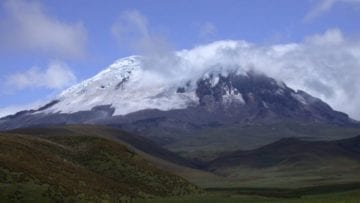
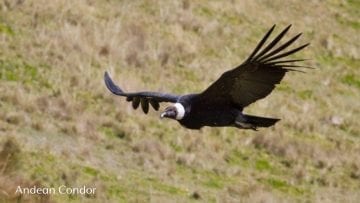
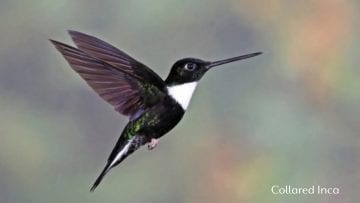
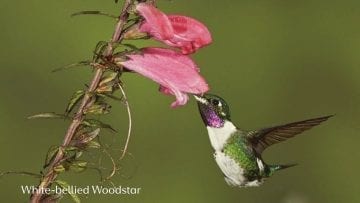
Unless you are joining the extension, the tour ends this morning with transfers to the airport.
This reserve (about an hour east of the city) is one of the best high altitude sites in Ecuador. On clear days, you can enjoy some of the most dramatic views in Ecuador, and the combination of great scenery and easy birding often mark this as people’s favorite site of the tour. Birding in the shadow of the huge snow cone of Volcan Antisana we will seek out Ecuador’s national bird, the Andean Condor, as well as Black-faced (Andean) Ibis, the exquisite Ecuadorian Hillstar, and numerous páramo species such as Chestnut-winged Cinclodes (Bar-winged) and Stout-billed Cinclodes, Streak-backed Canastero, Plain-capped (Paramo) Ground-Tyrant, Paramo Pipit, and Black-winged Ground-Dove. A large lake nearby usually has Andean Teal, Yellow-billed Pintail, Ruddy (Andean Duck), and, sometimes, Silvery Grebe. After lunch, we’ll drive about 1.5 hours over the Andes and stay at Guango Lodge for the night, which is beside a rushing river than often has Torrent Duck and White-capped Dipper, and boasts great hummingbird feeders. There will be time in the afternoon to take in the sight of the many hummingbirds buzzing around their feeders which attract species that we may have encountered before like Collared Inca, Buff-winged Starfrontlet, and Sword-billed Hummingbird, alongside others which are sure to be new, like Tourmaline Sunangel, White-bellied Woodstar, Long-tailed Sylph and Chestnut-breasted Coronet.
(5:30am breakfast in the Quito hotel, lunch in a restaurant in Antisana, night and dinner in Guango Lodge)
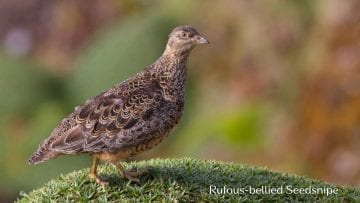
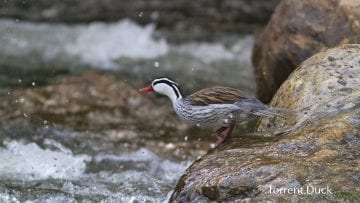
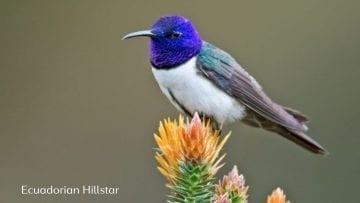
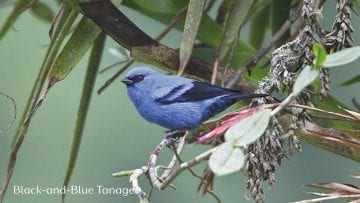
The exact plan for the day often is weather-dependent, but typically we start the day in some otherworldly treeline forest about 45 minutes from Guango looking for Masked Mountain-Tanager, Black-backed Bush-Tanager, Agile Tit-Tyrant, Paramo Seedeater, Shining Sunbeam, Viridian Metaltail, and White-chinned Thistletail, and other targets before driving back up into the paramo grasslands higher up. We’ll check stands of Polylepis woodland for Giant Conebill and seek out the beautiful Rufous-bellied Seedsnipe in the paramo itself. A few hummers even eke out a living up here, like Viridian Metaltail, Ecuadorian Hillstar, and Blue-mantled Thornbill. We’ll return to Guango for lunch, and bird there for a few hours, looking for mixed flocks with colorful birds like Lacrimose and Hooded Mountain-Tanagers, Blue-and-black Tanager, and Black-capped Hemispingus. We can also search again for Torrent Duck if needed. Late in the afternoon, we’ll return to Quito.
(Breakfast in the lodge at 5:30am, lunch could either be in Guango Lodge or a packed lunch, dinner and night in a hotel in Quito or near the airport).
The extension ends this morning with transfers to the airport (there are no birding activities). Please confirm the time of your transfer with your tour leader the day before. Breakfast is included unless you have a very early flight and have to leave the hotel before they start breakfast service.
Your wonderful 10-day birding tour in Ecuador comes to an end, but perhaps not your holiday. For the ultimate Ecuador birding experience, we advise to fly from Quito to the Galápagos Islands, where we recommend an 8-day expedition cruise. Contact us to discuss the endless possibilities.
This journey takes you to the soul of colourful Ecuador. You will visit colonial Quito, stay in a luxurious lodge in the most beautiful cloud forest of the country and you will go on an adventure at two grandiose haciendas in the Andes mountains.
A journey in which you combine your passion for golf with your love for nature and culture. You play beautiful golf courses, explore tropical forests, enjoy historic haciendas in the Andes, active volcanoes and the most beautiful colonial cities in South America: Quito and Cuenca, both declared UNESCO World Heritage Sites. You end your trip with a 4-day expedition cruise in the Galápagos Islands.
This beautiful, adventurous journey will introduce you to all facets of Ecuador. Nature and an active holiday predominate. You will explore the Amazon, mountain bike among the volcanoes and descend along refreshing waterfalls. The chosen hotels are basic but very good and attractive.
Aves Travels continuously seeks to amaze our guests with unique travel experiences. Aboard your intimate, 16-passenger, luxury yacht you will experience a unique variety of nature ranging from mangroves, cloud forests, pristine beaches to uninhabited islands equal to Galápagos atmosphere, vibrant fishing villages, local culture and exquisite gastronomy. This exclusive journey will take you to places that are extremely difficult to reach overland, making it truly an experience of a lifetime.